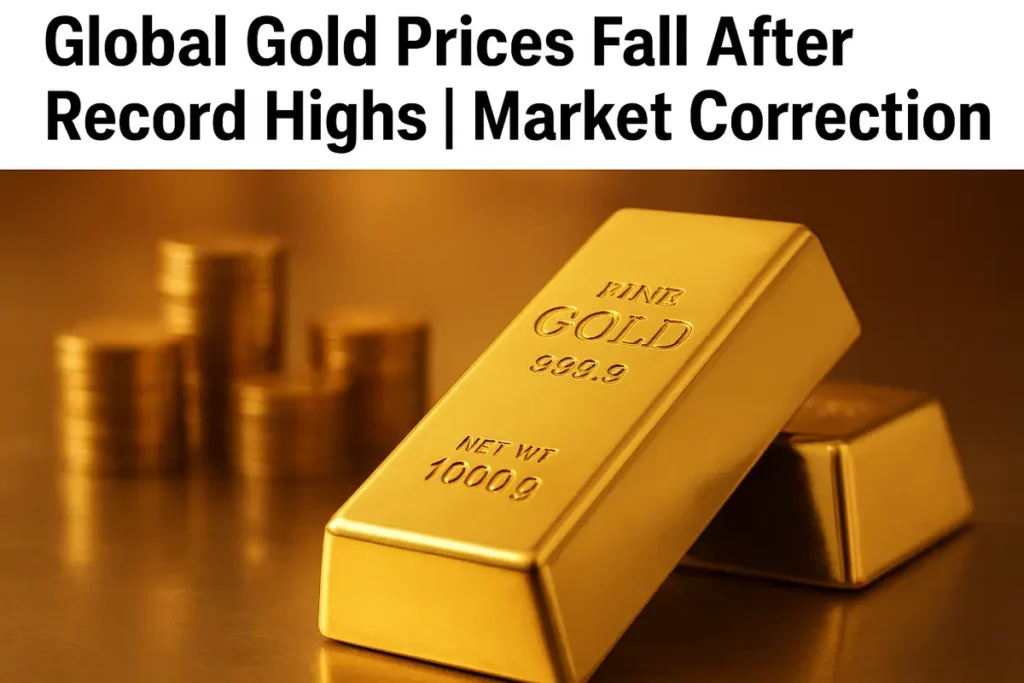
Global Gold Market Sees a Notable Pullback
The international bullion market witnessed a decline on Thursday, cooling off after hitting record highs earlier in the week. According to data from traders, the price of gold per ounce dropped by $20, bringing the benchmark down to $3,750 per ounce.
This decline comes only days after gold surged to an all-time peak of $3,790.82 per ounce, sparking debate among analysts about whether the rally had become overheated. The current correction is being seen as a natural pause, as investors took profits following weeks of gains fueled by safe-haven demand and global economic uncertainty.
Even with the fall, gold showed resilience later in the trading session. Spot gold edged up 0.6% to $3,756.29 per ounce, while US gold futures for December delivery rose 0.5% to $3,787 per ounce. Analysts note that while prices are easing, investor appetite for the metal remains strong.
Key Drivers Behind the Decline
Several factors are contributing to the latest dip in global gold prices:
- Profit-Taking After Record Highs
Many investors who benefitted from the recent surge chose to lock in gains, triggering selling pressure and weighing on prices. - Stabilization in Demand
The wave of safe-haven buying that drove gold to new highs earlier this week has eased slightly, allowing prices to cool. - Stronger US Dollar
A steadier US dollar has reduced the appeal of gold for investors holding other currencies, dampening immediate demand. - Positive US Economic Data
Stronger-than-expected US job figures and treasury yield gains have shifted some investment flows toward traditional markets. - Market Rebalancing
After a long bullish streak, analysts suggest that the pullback is part of a healthy rebalancing rather than the start of a major downtrend.
Silver, Platinum, and Palladium Defy the Trend
Interestingly, other precious metals moved in the opposite direction. Spot silver jumped 2% to $44.76 per ounce, reflecting strong industrial demand. Platinum gained 2% to $1,501.69 per ounce, while palladium advanced 1.8% to $1,231.21 per ounce.
Market analysts attribute these gains to resilient manufacturing demand and concerns about limited supply in the months ahead. Unlike gold, which functions largely as a hedge against economic uncertainty, silver, platinum, and palladium are more directly tied to industrial usage, particularly in technology, automotive, and energy sectors.
Historical Context: Gold’s Global Journey
Gold has been one of the most important assets in global finance for centuries, prized both for its cultural symbolism and its role as a store of value. Its price trajectory has mirrored major economic and political events — rising during wars, recessions, and currency crises.
In recent decades, the yellow metal has played a central role in global investment strategies, serving as a hedge against inflation and market volatility. Its resilience during economic downturns has only reinforced its reputation as a safe-haven asset.
The rally of 2025, which pushed gold near $3,800 per ounce, reflects both heightened geopolitical risks and the ongoing search for stability in uncertain economic conditions.
Impact on Global Investors
For global investors, the current dip in gold prices presents both risks and opportunities.
- Short-Term Traders may view the correction as a signal to reduce exposure until market sentiment stabilizes.
- Long-Term Investors, however, often see such dips as opportunities to strengthen holdings in an asset that has consistently preserved value over the long run.
- Portfolio Diversification remains a key reason for investors worldwide to maintain gold exposure, especially as equities and bonds face continued uncertainty.
Financial advisors generally recommend that investors avoid panic during price corrections, emphasizing that gold’s role as a hedge remains intact.
What the Correction Means for Consumers
For consumers, especially in regions with strong cultural demand for gold jewelry and ornaments, the drop in prices could provide a temporary window for purchases. Countries in Asia and the Middle East, which traditionally see higher seasonal demand during festivals and weddings, may experience renewed buying activity if prices remain under pressure.
At the same time, jewelers and retailers worldwide are watching the situation closely, as fluctuating prices affect inventory costs and consumer sentiment.
Outlook for the Coming Weeks
Looking ahead, market analysts believe gold prices will remain sensitive to a mix of economic and geopolitical factors, including:
- US Federal Reserve Interest Rate Policy: A hawkish stance could pressure gold further, while a dovish outlook might reignite demand.
- Global Geopolitical Risks: Conflicts and trade disputes often fuel safe-haven buying.
- Currency Market Volatility: Shifts in the US dollar, euro, and other major currencies will remain key drivers.
- Seasonal Buying Trends: Higher demand during cultural and festival periods could provide upward support.
Some experts predict that gold may retest recent highs if economic headwinds intensify, while others caution that stability in global markets could keep the metal under pressure in the short term.
Final Thoughts
The recent decline in gold prices reflects a pause in what has been one of the most significant rallies in recent memory. With international prices easing to $3,750 per ounce after hitting a historic high of nearly $3,800, the market now stands at a crossroads.
For investors, the correction may represent a strategic buying opportunity, while for consumers, it offers temporary relief in an otherwise expensive market. The coming weeks will be critical in determining whether gold consolidates, corrects further, or resumes its march toward new record highs.
One thing remains clear: gold’s status as a cornerstone of global finance and consumer culture is not changing anytime soon.